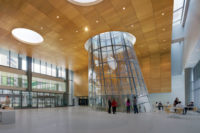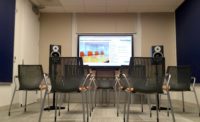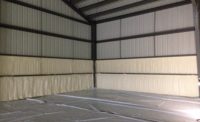What’s old is new again. Decorative thermoformed ceiling tiles and panels were a mid-20th century innovation made practical by post-war availability of thermoplastics and the adoption of modular suspended ceilings. Widespread use in signature commercial and institutional buildings gave way to changing tastes and, for the past few decades, thermoformed ceilings have been relegated primarily to residential and do-it-yourself use. Unaffected by damp, impervious to mold and easy to install, they became particularly popular for basement remodeling projects.
There is evidence, however, that tastes are shifting again. Thermoformed ceilings are going up in national chain stores as part of their visual branding, in schools and universities, libraries, hotels and restaurants, and all manner of non-residential buildings. As a result, professional ceiling installers are seeing thermoformed ceilings in architectural specifications with increased frequency.
Some contractors have even starting to recommend thermoformed ceilings as a problem-solving solution, for example:
- Project schedules can be accelerated because thermoformed ceilings can be installed while building interiors are still damp enough to cause mineral fiber panels to sag.
- Costs can be slashed by using thermoformed panels in “drop-out” ceilings installed beneath fire sprinklers. This eliminates the need to extend sprinkler heads through the ceiling and simplifies trade coordination. (See Bench Test: “A Check-in on Drop-out Ceilings,” Walls & Ceilings, September 2014)
- Working conditions and safety can be improved and the need for personal protective equipment is reduced; thermoformed ceilings are free from the dust and irritating fibers of conventional acoustical ceilings and the sharp corners and snags of metal panels.
- Labor is reduced because thermoformed panels are very lightweight and easy to cut with scissors or snips; they do not stain, break or fray at edges due to installation or handling by subsequent trades.
Decorative Potential
Ceilings are the most visible architectural surface in most buildings. A plain, flat overhead surface defined by squares and rectangles has a rigorous logic but is often lacking in passion, what Robert Venturi, an architectural philosopher, characterized as, “Less is a bore.”
Thermoformed panels are fabricated by molding thermoplastic sheet, usually rigid vinyl, under heat, pressure, and vacuum. Typically just 0.013 to 0.030-inches thick, the panels maintain their shape due to their three-dimensional relief. Dozens of patterns are available with motifs ranging from historic reproductions of ornamental plaster and stamped tin ceilings to modern geometric and abstract forms. They are also available in a palette of solid colors, faux wood and metal finishes, and light transmitting options, and sized to fit 24- by 24-inch and 24-inch by 48-inch suspension grids.
If these options still do not satisfy a project’s aesthetic demands, further architectural expression is possible by combining patterns and colors, staggering or rotating panel orientations, and using back illumination to create luminous ceilings and special effects.
Beautiful Performance
Decorative ceilings exceed contemporary performance expectations and withstand the rigors of use. Not all thermoformed panels are produced alike, so it is important to view samples and manufacturer’s test data before purchasing.
Look for panels that have Greenguard Gold certification for indoor air quality, a Health Product Declaration for chemical transparency, and a listing by a building code evaluation agency such as IAPMO-UES. Panels should also have Class A surface burning characteristics, high stain resistance and washability, and acoustic performance up to NRC=0.85.
With all these attributes, savvy contractors are taking this page from mid-century modern’s past to write exciting new chapters and happy endings for themselves and their customers.








Report Abusive Comment